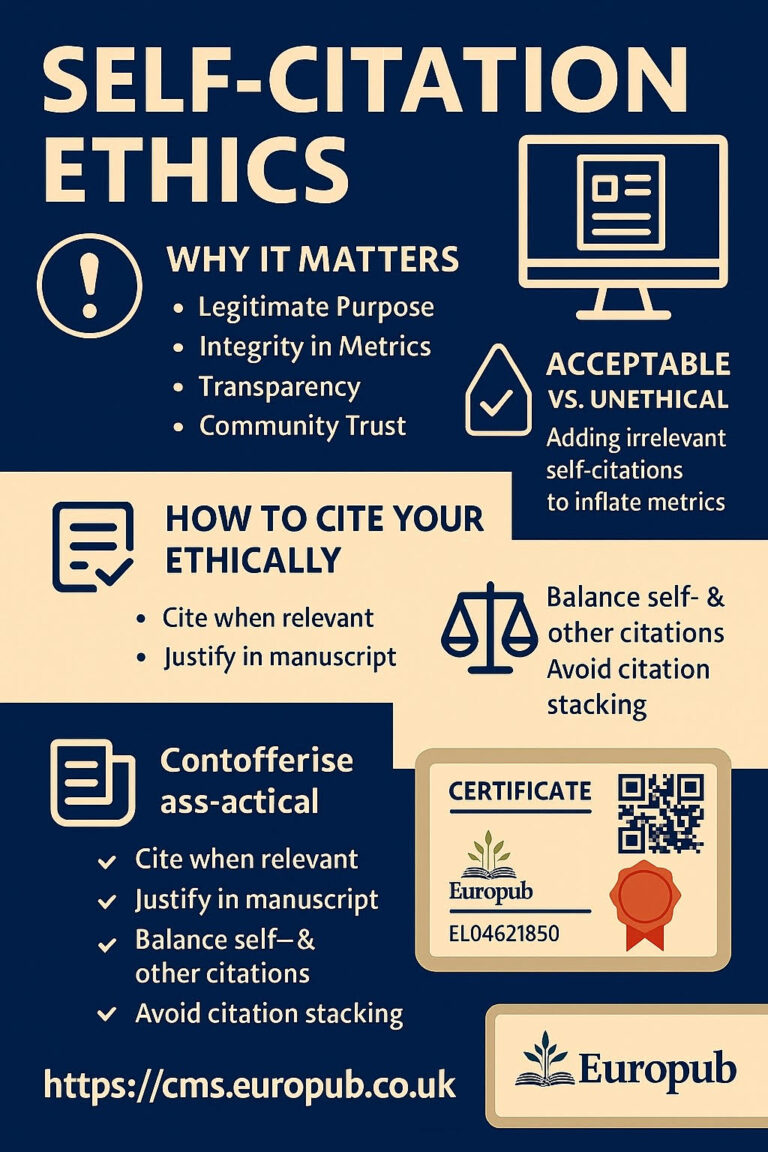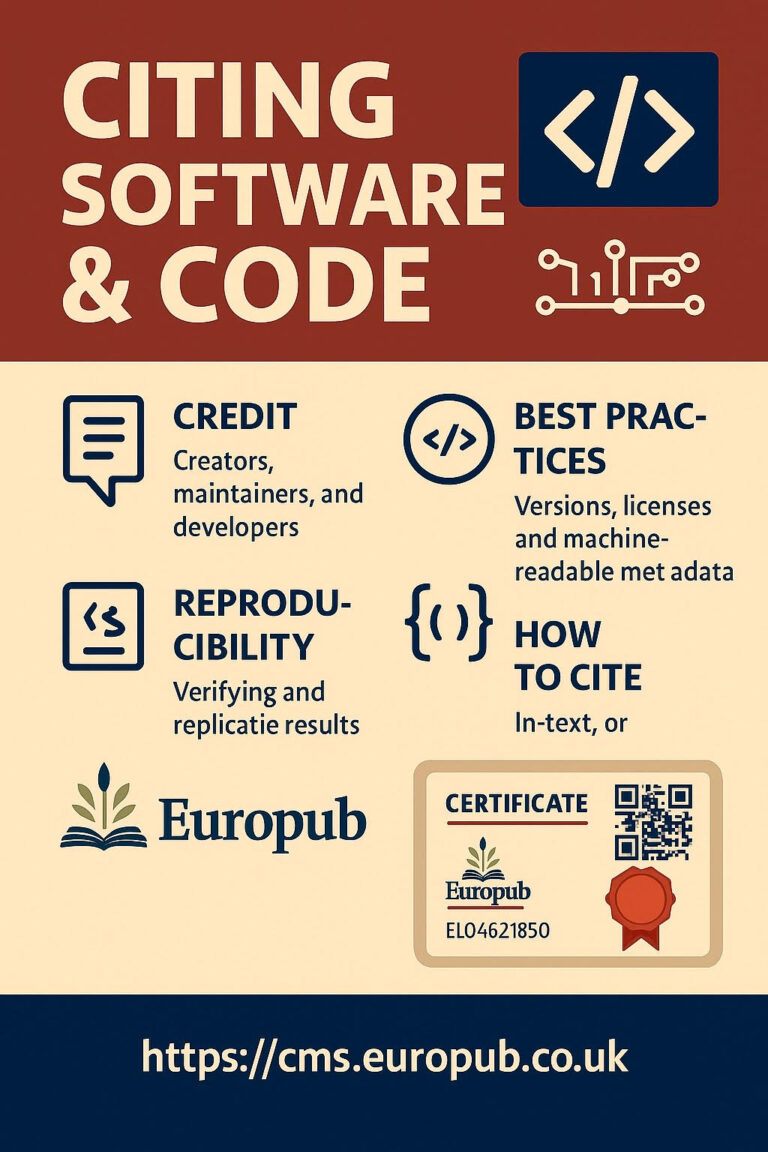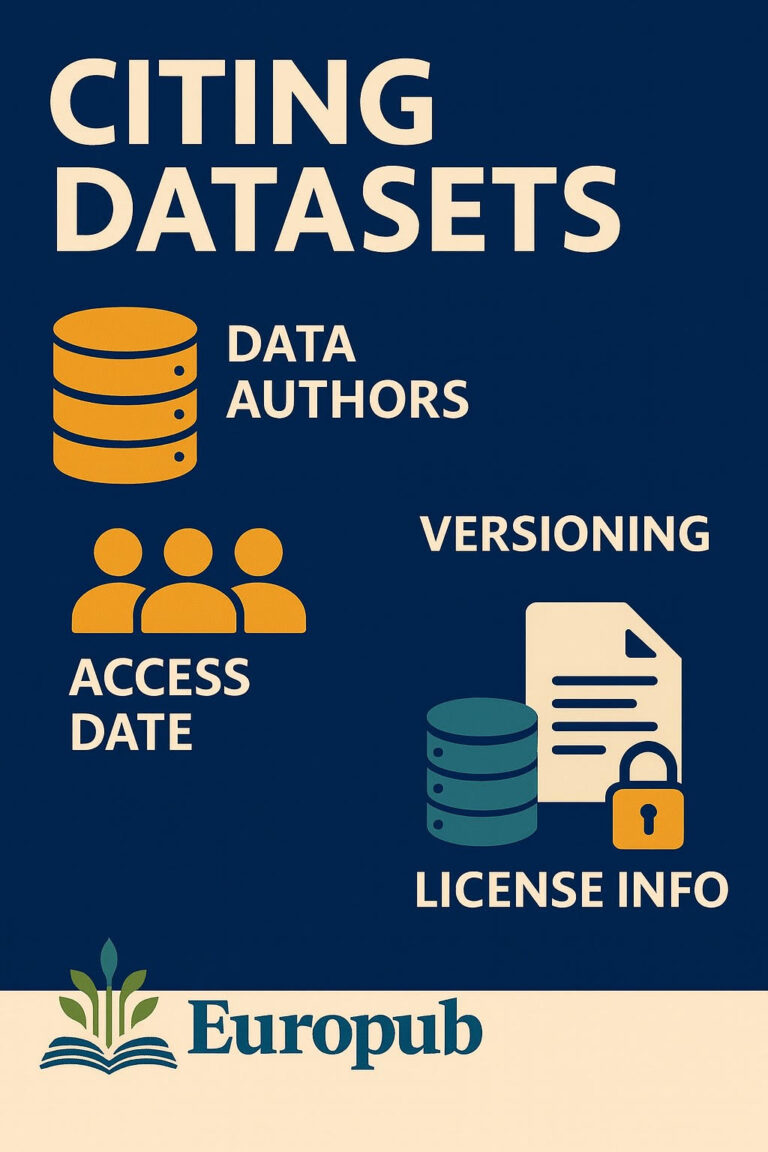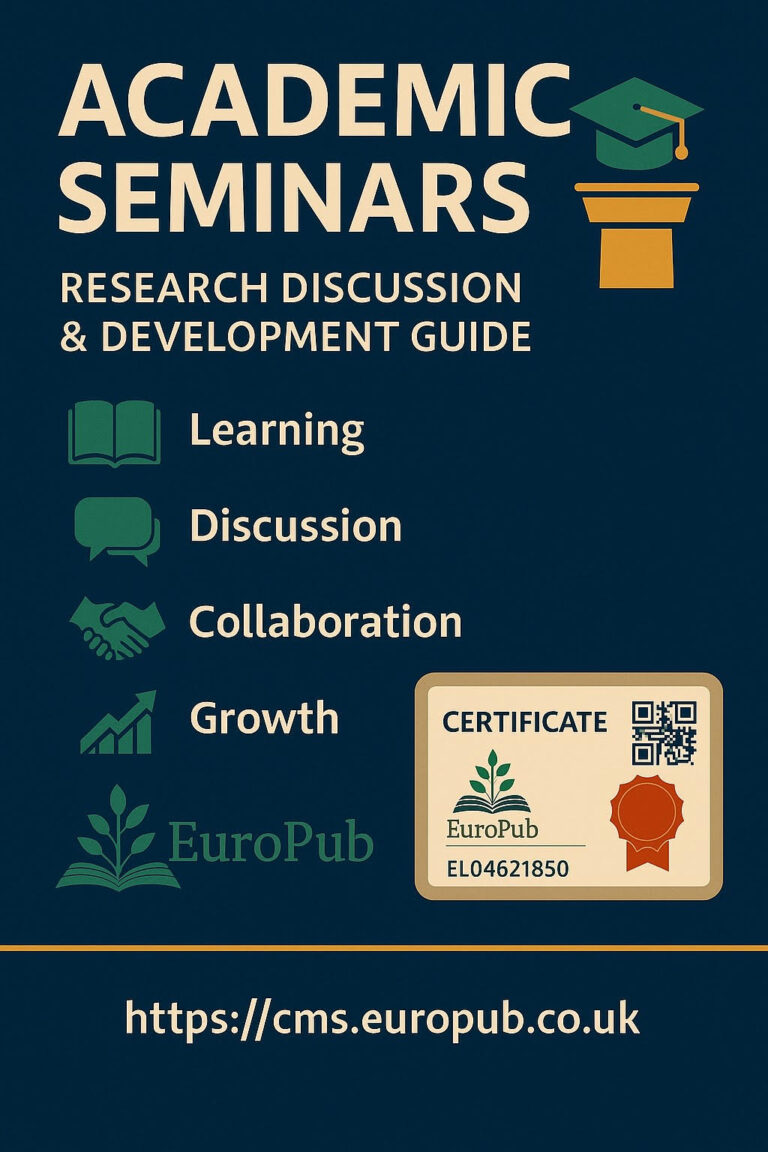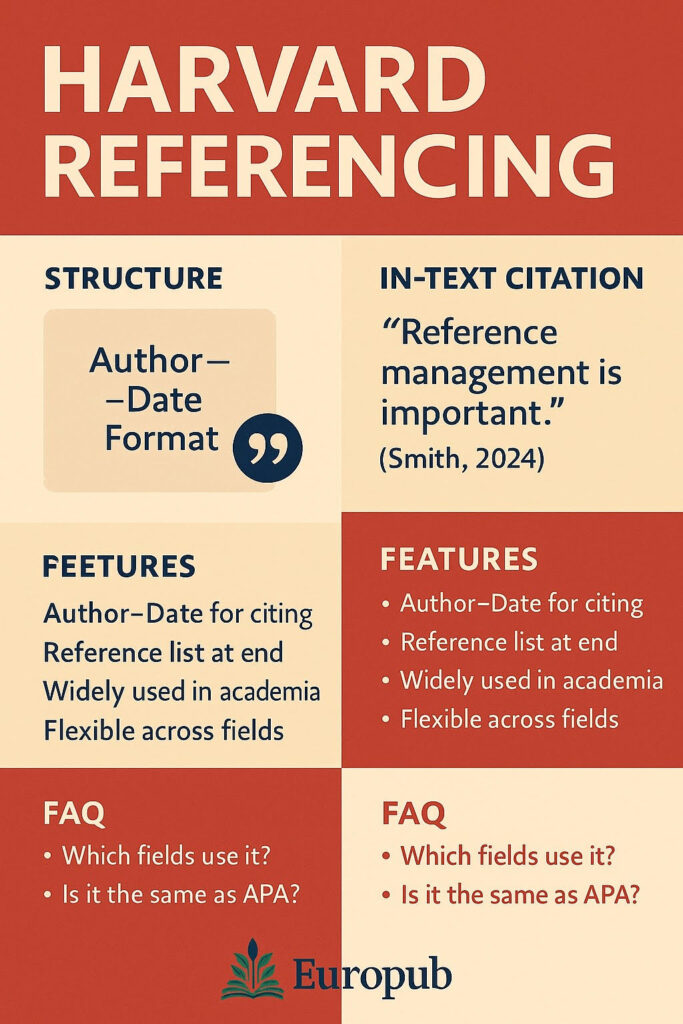
 Overview
Overview
The Harvard Referencing Style is one of the most widely used citation systems in academic writing.
It follows an Author–Date format, making it easy to identify when and by whom a source was published.
This system is particularly common in social sciences, business, education, and humanities, and is recognized by thousands of journals worldwide — including many indexed in Europub.
Harvard referencing ensures clarity, academic integrity, and traceability of ideas, helping readers verify every claim made in a scholarly paper.
 Core Principles
Core Principles
- Every in-text citation must correspond to an entry in the reference list.
- References are arranged alphabetically by author’s surname.
- In-text references include author surname + publication year.
- Page numbers are required for direct quotations.
- All sources must be verifiable and complete.
 In-text Citation Examples
In-text Citation Examples
| Type | Example |
|---|---|
| One author | (Smith, 2020) |
| Two authors | (Brown and White, 2021) |
| Three or more authors | (Johnson et al., 2019) |
| Organization as author | (World Bank, 2023) |
| Multiple sources | (Khan, 2018; Lee, 2020) |
| Direct quotation | “…” (Anderson, 2022, p. 15) |
 Reference List Formatting
Reference List Formatting
| Source Type | Example |
|---|---|
| Book | Smith, J. (2020) Global Marketing Strategies. London: Routledge. |
| Edited book | Brown, L. and Taylor, J. (eds.) (2021) Perspectives on Education. Cambridge: CUP. |
| Book chapter | Allen, M. (2019) ‘Digital policy in education’, in Roberts, T. (ed.) Digital Learning Today. Oxford: OUP, pp. 22–37. |
| Journal article | Lee, S. (2022) ‘AI applications in journalism’, Journal of Media Studies, 18(3), pp. 110–129. |
| Conference paper | Gupta, R. (2021) ‘Nanotech applications in agriculture’. Proceedings of the 5th International Conference on Smart Farming. Dubai: IEEE, pp. 55–61. |
| Website | Europub (2024) Certificate Management System. Available at: https://cms.europub.co.uk (Accessed: 20 March 2025). |
| Thesis | Harris, N. (2020) A Study of Renewable Energy Economics. PhD thesis, University of Leeds. |
| Report | OECD (2023) Education at a Glance 2023. Paris: OECD Publishing. |
| Dataset | UN Data (2024) Global Population Statistics. Available at: https://data.un.org (Accessed: 12 Feb 2025). |
 Formatting Rules
Formatting Rules
- Use italics for titles of books, reports, and journals.
- Use single spacing and a hanging indent (0.5 inch).
- List all authors up to three; use et al. for four or more.
- Include DOI for journal articles when available.
- Use sentence case for article titles and title case for books/journals.
 Difference from Other Styles
Difference from Other Styles
| Feature | Harvard | APA | MLA | Vancouver |
|---|---|---|---|---|
| In-text format | Author–Date | Author–Date | Author–Page | Numbered |
| Reference order | Alphabetical | Alphabetical | Alphabetical | Sequential |
| Page numbers | For quotes | For quotes | For quotes | Always numeric |
| Common fields | Social sciences, humanities | Psychology | Literature | Medicine |
 Best Practices
Best Practices
- Keep all citation data consistent across drafts.
- Verify online sources before submission.
- Avoid broken URLs or incomplete access dates.
- Check journal-specific requirements (some modify Harvard slightly).
- Use reference managers (Zotero, Mendeley, EndNote).
 Automation Tools
Automation Tools
You can use citation generators:
 Useful Links
Useful Links
- Harvard Referencing Guide – Anglia Ruskin University
- CrossRef DOI Lookup
- Europub Certificate Management System
 FAQ — Harvard Referencing (Extended)
FAQ — Harvard Referencing (Extended)
 Formatting
Formatting
Q1: What fields use Harvard referencing?
A: Social sciences, management, law, humanities, and education.
Q2: How is the in-text citation structured?
A: (Author, Year) — e.g., (Taylor, 2023).
Q3: How to cite multiple works by one author in a year?
A: Use letters — e.g., (Smith, 2020a), (Smith, 2020b).
Q4: What if there’s no author?
A: Use the title in place of the author — e.g., (Climate Policy Report, 2021).
Q5: Should the reference list include page numbers?
A: Only for book chapters and journal articles.
 Reference List
Reference List
Q6: Is the list alphabetical or numerical?
A: Alphabetical by author surname.
Q7: How many authors before using et al.?
A: List up to 3 authors, then use et al.
Q8: Do I need DOI links?
A: Yes, always if available.
Q9: How do I cite an online source with no date?
A: Use “n.d.” for “no date” — e.g., (Brown, n.d.).
Q10: Can I include retrieved dates?
A: Yes, mandatory for all online sources.
 Sources
Sources
Q11: How to cite a translated book?
A: Add translator: “Translated by [Name]” after the title.
Q12: How to cite a government report?
A: Include agency name as author.
Q13: Can I cite social media?
A: Only if it’s from an official, verifiable source.
Q14: How to cite lecture notes?
A: (Lecturer’s surname, Year) — unpublished material.
Q15: How to cite an image?
A: Artist/Photographer, Year. Title of image. Available at: URL.
 Accuracy & Integrity
Accuracy & Integrity
Q16: Should I verify all references?
A: Yes, check all DOIs and URLs.
Q17: How often do journals update their reference rules?
A: Usually every 2–3 years.
Q18: What happens if my reference style is inconsistent?
A: It may lead to rejection or revision requests.
Q19: Does Europub verify reference formats?
A: Yes, all submissions undergo citation verification.
Q20: Can I obtain a verification certificate?
A: Yes, via https://cms.europub.co.uk
 Advanced FAQ
Advanced FAQ
Q21: What are secondary citations?
A: When citing a source cited in another work — always use both.
Q22: Can I use Harvard in biomedical journals?
A: Usually not — use Vancouver instead.
Q23: Is punctuation flexible?
A: No, punctuation must be consistent.
Q24: Can titles be in quotation marks?
A: Only for articles, not for books or journals.
Q25: Is Harvard accepted by Europub-indexed journals?
A: Yes, for non-medical disciplines.
Q26: How to check journal preferences?
A: Visit each journal’s “Author Guidelines” page.
Q27: Can Europub issue citation format training certificates?
A: Yes, via its Certificate Management System.
Q28: Should URLs be hyperlinked?
A: Preferably yes in online submissions, but not required in print.
Q29: What’s the best tool for managing citations?
A: Mendeley or Zotero (both integrate with MS Word).
Q30: What’s the key advantage of Harvard style?
A: Readability and flexibility across disciplines.
 Prepared by: Europub Publishing Company Ltd. UK
Prepared by: Europub Publishing Company Ltd. UK
 Certificate & Citation Verification: https://cms.europub.co.uk
Certificate & Citation Verification: https://cms.europub.co.uk
